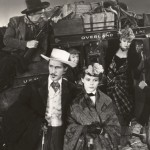
Stagecoach – 1939
I’ll say, right off the bat, that I am generally not a fan of Westerns. I don’t hate them, I just have never gone out of my way to see them. So when Stagecoach came up in the queue, I gave a little sigh and settled in for the duration.
But darn it if the film didn’t surprise me. The film could almost have taken place in any time period, but director John Ford was particularly fond of Westerns. Specifically, he was looking for a script that would make the movie’s main actor a star. And boy, did it work.
John Wayne was that star, and though he had been acting in Hollywood for around ten years, he was not as big a name as he was destined to become. He played the part of The Ringo Kid, a good natured man with a dark past. By today’s standards the character was a stereotype, but in this case it worked. In fact, every character in the film was a stereotype on purpose.
The movie was about a ragged group of strangers that were all put into a dangerous situation. The drama of the film was not so much the life-threatening hardships they faced, but the interactions between the characters. And it was brilliantly done.
Claire Trevor was Dallas, the hooker with the heart of gold, and The Ringo Kid’s main love interest. Andy Devine played the moronic Stagecoach Driver, Buck. John Carradine was Hatfield, the gambler with a sense of honor. Thomas Mitchel played Doc Boon, the alcoholic medicine man. Louise Platt was Lucy Mallory, the snooty woman who was pregnant and trying to get to her husband. George Bancroft played Marshal Curly Wilcox, the law man who is out to arrest the Ringo Kid. Donald Meek was the mousy salesman Samuel Peacock. And finally, the rich aristocrat who was secretly a crook, Henry Gatewood, was played by Berton Churchill.
The interactions between the different characters against the backdrop of the dangerous Apache Indians is what made the movie good. Each character had his or her own motives which drove them to make decisions that affected the entire group. They each had their own past and their own skills which either helped them all to survive, or put them all into further danger.
In particular, I really liked Doc Boon. He was an unapologetic drunk who sobered up when he needed to, but happily went back to the bottle with his work was done. He also had a bit of shared history and a soft spot for Dallas. He proved to be a good man, despite being inebriated most of the time. Thomas Mitchell did a great job playing the part.
Now, John Wayne was still fairly young when he was in Stagecoach, but you could tell he was an actor who knew what he was doing. He used facial expressions to show emotions and his dialogue to propel the story in a way that did not seem forced or fake. He had a good sense of timing and pacing. And like many actors in Hollywood, he was pretty easy on the eyes in his youth.
However, I will make mention of the character of Samuel Peacock. He seemed like a throw-away character. He had so little to do and not very much to say. He spent much of his time in the background. The film could have done without him except that he was a salesman who sold liquor, providing Doc Boon with the spirits he needed to stay drunk. Another rough point was the romance between The Ringo Kid and Dallas. It seemed underdeveloped and came out of left field. But I guess the filmmakers wanted the final shot of the film to be the happy young couple riding off into the distance, a life of wedded bliss awaiting them.
You would think that the Indian attack would have been the climax of the film, but you’d be wrong. Sure, it arrived late in the movie, and one of the passengers of the Stagecoach was actually killed. But it was over quickly and there was still a gunfight ahead that was like the Ringo Kid’s personal battle. Of course, the romance made the shoot-out more intense, or was it the other way around? Either way it gave Wayne his own victory that the star of the movie needed to impress the audiences. And I was impressed as well… despite myself.








